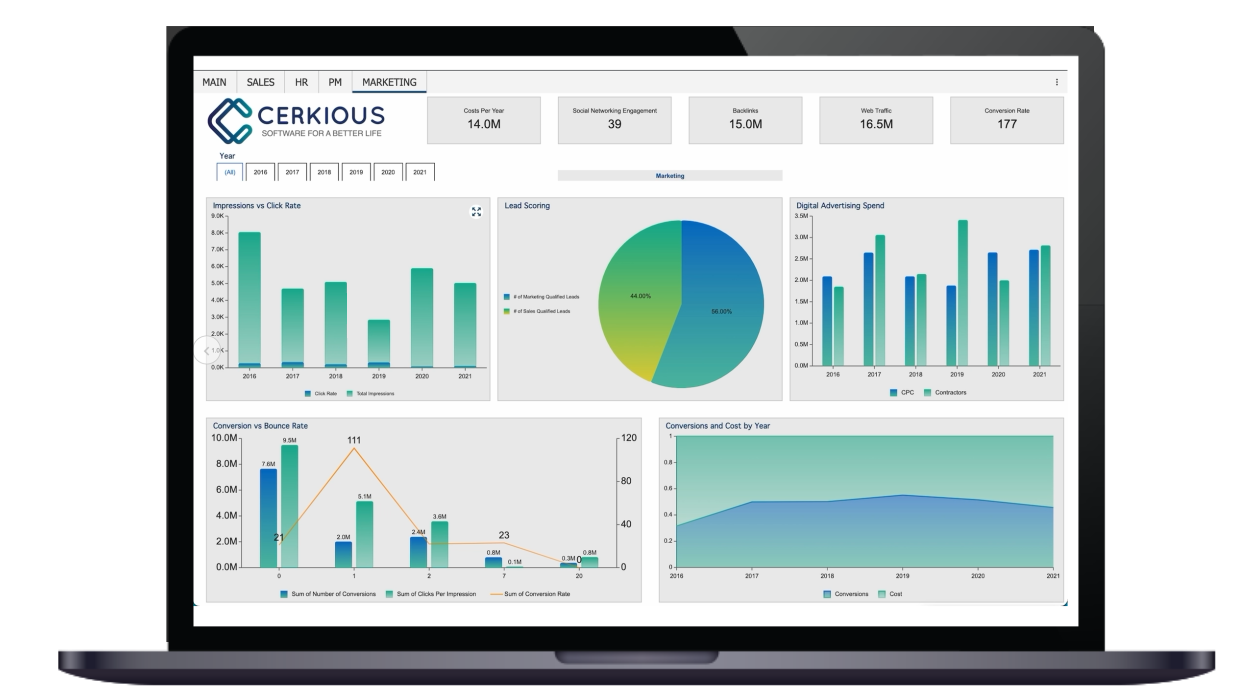Insurance is based on the idea that risk can be spread out over multiple entities. An insurance company bets that only a certain percentage of these insured entities will experience a loss event. They assess the risk to insured parties and charge them a premium that covers expected losses and leaves them with a profit after claims and expenses.
An insurance company needs to be able to properly analyze the probability of a loss. While there is more to the insurance industry than that, taking information and assessing the likelihood of adverse occurrences forms the basis of operations, from setting premiums to establishing reserves and developing new products.
In this article, we will use the term business intelligence (BI) to mean the collection and analysis of data related to a business. BI is a broad area that includes reporting, complex analytics, data visualization, dashboards, and a long list of other capabilities that all assist in making business decisions.
Embedded BI is the ability to integrate BI findings (tables, dashboards, visualizations) in your team’s applications to do their jobs. Embedding BI puts needed information on hand without users having to log in to a separate application, integrating the information without users having to log in to a separate application, and integrating the information into the standard workflow.
This article will look at seven areas where embedded BI contributes to decision-making in the insurance industry and how embedding can be used to make these processes more effective.
1. Risk Management
Risk management refers to understanding the probability and causes of a given risk and taking action to mitigate it. Take life insurance, for example. While death is inevitable, life expectancy can be increased by following certain practices, like not smoking, maintaining a healthy weight, and not engaging in risky activities (aerobatic flying, for instance). Controlling these factors is central to risk mitigation.
It’s important to note that risk management differs from uncertainty management. Risk management involves understanding the causes of a loss event and taking steps to mitigate its possibility or severity. Another good example of this is fire insurance. While we cannot be certain that a fire will occur at a given location, we can still mitigate the risk of it. Mitigation may include fireproof building materials, installing fire alarms and fire suppression equipment, and the knowledge of the nearest fire hydrant’s location.
BI allows insurance companies to look at untoward events, ascertain their causes, and determine what actions might have mitigated the loss. They can then advise their customers according to their findings and adjust their premiums depending on how closely the advice is followed. Each of these actions requires us to obtain and analyze the characteristics of past events.
Consider the construction of an office building. In choosing building materials, risk management might say that the constructor should choose fire retardant materials based on the analysis of past occurrences and laboratory testing. Mitigation requires BI to assemble and analyze a variety of data. However, if builders ignore this risk management advice, the insurer can raise their premium or decline to insure the project. Any of these actions require the use of data provided by BI to inform the decision.
If the insurer is consulting with a builder in risk management, embedding BI into applications is useful. Typically, the insurer has a list of questions about the building construction and other items discussed above. For each item, embedded BI can provide a dashboard of how risks increase based on the variables discussed. With this information at their fingertips, the insurer can adopt a consultative approach to risk management. Reducing insurance premiums might offset the additional cost of fire-retardant materials, providing a better risk profile to the insurer and the insured.
2. Combat Fraud
Insurance fraud can take a wide variety of forms. Some of these include false loss claims, inflated repair bills, or medical bills for someone not in the vehicle, to name a few.
Analytics is used extensively by insurance companies to detect claim anomalies that are indicators of potential fraud. For example, an automobile repair shop charging above market rates or doing significantly more of a specific repair than the average shop in the area may merit further investigation. Excessive losses reported by an individual or group may also be a reason to investigate.
While BI cannot prove fraud, it can indicate which cases are abnormal and should be subjected to further investigations. If a case is flagged, it is referred to an investigator with the relevant background details. Embedded BI allows the investigator to drill down into the data that triggered the flag. This feature can be particularly useful for field investigators using mobile devices. They can access case specifics, client loss history, and other information that caused the case to be flagged. Having this information when visiting a client, or reviewing a loss claim, can allow them to be more specific about their investigation and speed assessment of determining factors.
3. Improve Customer Service
In customer service, understanding why a customer is calling is key to solving their problem satisfactorily and quickly. BI is used to analyze why customers are calling and can be embedded into customer service functions to route them quickly to the information they need. Analyzing call reasons to develop frequently asked questions as part of the support website is just one example of how we can use BI.
When a customer is routed to a customer service representative (CSR), embedding BI in the customer service system provides information to the CSR to speed their call handling. For example, let’s take the example of a question asked about a claim. Embedded BI can show the CSR information on the average processing time for a claim or the most likely reasons for a delay. CSRs can then discuss potential delays with the customer and determine if any of these (such as missing forms) are a problem. Embedding BI into the workflow allows the CSR to speed up the handling of customer problems.
4. Product Development
Product development for the insurance industry includes idea creation, product feasibility tests, underwriting guidelines, product planning, product design, pricing, reinsurance, state filings, and marketing. Each of these steps is data intensive. Depending on the workflow and applications you are using in your product development, embedding BI into it can speed up the process.
Let’s look at one aspect: product feasibility tests. Product feasibility attempts to answer questions like:
· Are losses predictable for the product?
· Are there enough losses to create a market for the product?
· How well can the cost of loss be defined and assessed?
· Will the product compete or cannibalize other similar products we have?
Answering these questions requires data. Knowledge workers can access and analyze this data and embed it in documents they are creating for a more efficient and less error-prone workflow. Embedding BI into product development templates or tools increases the velocity of bringing a new product to market.
5. Improving Marketing
Insurance marketing today is a broad area that can be improved by embedding BI in applications. The insurance market is omnichannel, selling through captive and independent agents, email, the internet, and association marketing (including businesses offering insurance to their employees).
Independent agents can sell a variety of products from a variety of companies. An insurance provider must ask, “How can I convince them to sell my product versus my competitors?” Embedding BI into your marketing applications or materials can make it easier for independents to sell your products.
For example, you might embed a market identification tool in your marketing materials. This tool could allow the agent to select a geographic area and determine the density of prospects for a given product based on demographics and marketing analytics, helping them understand the market and target the best places for marketing campaigns. By embedding it in the marketing materials, we make it easier for the agent to go straight from the materials to marketing planning.
Other features, like creating mailing lists for select areas, could make it easy for the agent to mail your company’s materials for their campaign.
6. Enhance Security
Insurance companies are responsible for large amounts of personal and confidential information of their clients. They are also responsible for handling large amounts of money, including payments, investments, and cash reserve funds. These factors make them a prime target for bad actors. In addition, the expansion of data and operations housed in the cloud or multi-cloud environments offers a greater attack surface to be protected.
Like most large enterprises, insurance companies rely on third-party security platforms and services cloud vendors provide to secure their data. These platforms monitor security risks and alert the enterprise to needed actions. Playing a pivotal role in securing the enterprise, they generate a significant amount of data from disparate sources. The security professionals’ role is to monitor and analyze this data to harden the enterprise against attacks. Embedded BI works with security software to create analytics and visualizations of security data. It enables the security professional to assemble data from disparate sources and provides a unified picture of the security situation.
For example, it allows them to see whether security patches have been applied in the cloud environment. It may show that certain geographical areas are more vulnerable to incursion and need additional hardening. Embedded BI allows the security professional to analyze and act on information without leaving the security platform.
7. Claims Handling
Claims handling is a crucial function of any insurer. No matter what type of insurance, customers want their claims quickly handled while providing the insurer with minimal additional information. Likewise, insurance companies want to minimize the cost of processing claims while ensuring the amounts paid are justified. If possible, companies want to automate the processing of claims by establishing guidelines for automatic payment and referring only outliers to claims processors.
Embedded BI works within the claims process to assist adjusters and supervisors in streamlining the claims process. Embedded BI allows the processor to consult the dashboard or other analytics concerning the claim they are processing.
For example, what were the costs of similar claims? Or, if requested, did the additional information affect the amount paid. These results might indicate that the claim should be paid without requesting information. Or it may indicate that the claim or type of claim requires additional scrutiny. In either case, providing claims processors with information they can use within the current workflow allows for fine-tuning the claims process.
Conclusion
BI and analytics are central to the success of virtually all phases of an insurance company’s processes. They affect decision-making in product development, marketing, and virtually every stage of the company’s operations. Embedding BI into the everyday workflow of enterprise speeds these processes, placing information in the hands of knowledge workers when they need it.
Tools like Wyn by GrapeCity make it easy to embed BI in your company’s processes. Learn how to use Wyn to create a dashboard in just five minutes.






























